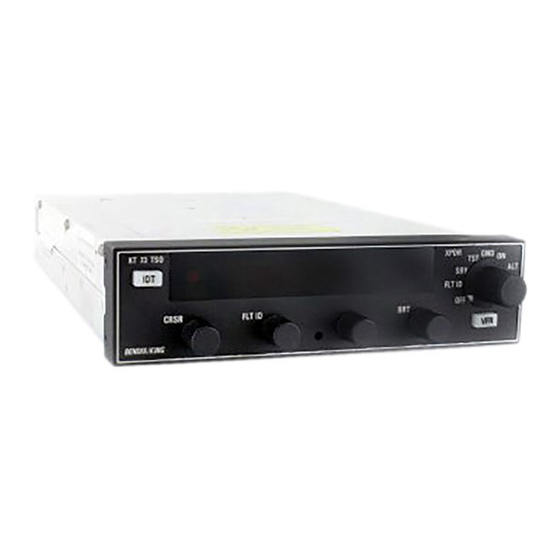Advertisement
Quick Links
KT 73 Transmitter/Modulator Module (Theory of Operation)
1.0
Modulator Board
The modulator board drives the transmitter according to the signals received from the RLSI chip
on the main board. The KT73 modulator can be divided into the five major blocks: TX_SENSE
module, 50V regulator, collector modulator, emitter modulator, and TX/RX switch. Figure 1
Modulator Board Block Diagram below shows these functions. The modulator schematic is KPN
002-08274-0020.
RX_EN_NOT
TX_SENSE_MB
+65 V DC
MOD_TRIG
1.1
TX_SENSE Module
The TX_SENSE circuit detects the transmitted pulse, converts it into TTL format and
sends it to the RLSI. The detected signal is used to verify that the squitter function is
working. The detection circuit consists of a detector diode CR2, resistor R5, and
capacitor C18 on the transmitter board. The detected RF is sent to the modulator board
via E4 and is then buffered by Q12 on the modulator board. Modulator board U1 whose
output is TTL compatible then inverts the TX_SENSE.
1.2
50 V Regulator
The 50 V regulator takes the 65 V from the power supply and regulates it to 50 +/- 1.5
VDC. The circuit uses two power transistors Q2 and Q3 (both Darlington) on the
modulator board and a voltage divider network that supplies the base drive to the two
Darlington transistors. The regulator consists of Q1, CR3, R4, R5, R34, and R6 on the
modulator board. In a steady state, when the 65 V line is at 65 V, the regulator keeps the
bases of the Q2 and Q3 Darlington at 50 VDC. As the voltage on the 65 V line drops, the
base voltage for Q3 drops, reducing the collector current of Q3 and raising the base
currents for the darlingtons. The is the as the 65 V line drops, the voltage drop through
Honeywell International Inc.
Olathe, Kansas
KT73_TxMod_Theory.doc
Proprietary Information
Figure 1 Modulator Board Block Diagram
TX/RX SWITCH
TX_SENSE
MODULE
50 V
REGULATOR
COLLECTOR
MODULATOR
EMITTER
MODULATOR
RX_NOT
TX_SENSE
COLLECTOR
MODULATION
EMITTER
MODULATION
Page 1 of 4
Advertisement

Summary of Contents for Honeywell KT73
- Page 1 The modulator board drives the transmitter according to the signals received from the RLSI chip on the main board. The KT73 modulator can be divided into the five major blocks: TX_SENSE module, 50V regulator, collector modulator, emitter modulator, and TX/RX switch. Figure 1 Modulator Board Block Diagram below shows these functions.
- Page 2 Q5, which is used primarily to the RF output pulse width. Q5 stays on until it V is less than two volts and CR5 prevents the gate of Q3006 from, going below –12 volts. Honeywell International Inc. Page 2 of 4 Olathe, Kansas KT73_TxMod_Theory.doc...
- Page 3 Bandpass Filter FL1 is centered at 1090 MHz. with a 3 dB bandwidth of 10 MHz. The purpose of the filter is to keep the oscillator on frequency over temperature. As the temperature varies, so does the insertion phase through the transistor. This causes a Honeywell International Inc. Page 3 of 4 Olathe, Kansas...
- Page 4 130 Ω. The coaxial cavity was created to have a high impedance line that would in turn create high Q inductors. The filter has 55 dB of attenuation at the second and third harmonics. Honeywell International Inc. Page 4 of 4 Olathe, Kansas...













